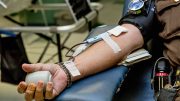By: Al Gentile/TRT Reporter—
Research, prevention, and treatments of HIV and AIDS has, in the last decade, made the disease anything but a death sentence. With new treatments and fresh efforts from advocates calling for prevention, treatment, and ready availability of resources, those living with HIV/AIDS and their loved ones have found new ways to live healthy and productive lives.
Human Immunodeficiency Virus (HIV) is a retrovirus that breaks down a patient’s immune system so severely which, if left untreated, can cause Acquired Immune Deficiency Syndrome (AIDS). If the virus develops into AIDS in a person, they are rendered helpless to even the most basic of infections.
Patients die from AIDS by contracting infections, which their immune systems could have typically fought off, such as tuberculosis and non-Hodgkin’s Lymphoma. [pullquote]New infections happen every day. The Center for Disease Control (CDC) estimates 50,000 people become infected every year. Sciortino said in Massachusetts alone, 700 new infects are registered annually. Though that is down by 41 percent from 2000, he said the fight is not over.[/pullquote]
The U.S. government’s HIV/AIDS information website states that HIV is most commonly spread through unprotected vaginal or anal sex, where bodily fluids come in contact with tears in tissue, which allows fluids to enter the blood stream. HIV is also commonly spread through intravenous drug use through the sharing of needles.
Pregnant mothers can also give HIV to their children through child-birth and breastfeeding.
Getting over the stigma
Each day, thousands deal with the social impacts of HIV/AIDS. Steve Hourahan, executive director of AIDS Project Rhode Island, an advocacy group which focuses on offering services, information, and testing to HIV/AIDS-positive patients, said the stigma surrounding people living with HIV/AIDS is rooted in fear.
“Years ago, there was a much stronger focus on it,” Hourahan said “People were on the streets and were dying.”
Hourahan, said getting tested is an incredibly difficult undertaking. With misinformation abound, many are afraid to receive what is still known as a “death sentence” both medically and socially.
“One of the things about testing is it takes absolute courage,” Hourahan said.
People who live with the disease, Hourahan said, have a hard time coming to terms with informing their loved ones in fear of breaking relationships.
“I know clients who are married that don’t disclose,” Hourahan said.
According to him, the risk of spreading the disease becomes minimal when a patient keeps up with current anti-retroviral treatments because their “viral load,” or the amount of the virus in the blood, can be brought to what experts call “undetectable” levels.
Carl Sciortino, executive director of the AIDS Action Committee of Massachusetts (AAC), said the stigma becomes far more intense when it comes to gay men. [pullquote]“With the tools we have now, we have the ability to change the game where it relates to HIV and bring this chapter to a close,” Sciortino said.[/pullquote]
“Whenever you talk about sexual health and gay men’s health, you will run into resistance,” Sciortino said. “People are just not comfortable putting all that out there.”
Cindy St. George, executive director of the AIDS Foundation of Western Massachusetts, (AFWM) said the stigma is even, to this day, institutionalized.
“It’s well documented that people who have an HIV diagnosis are more likely to spend time in jail,” St. George said. “They also tend to serve longer terms and harsher sentences.”
Education, St. George said, is the most important part of fighting stigmatization.
“The sooner that it starts in the public school system the better,” St. George said.
A different landscape
The treatment of HIV/AIDS has come to a point where people can live with the disease to be healthy, happy, and still sexually active.
Fenway Health, an LGBT-centered health research facility and advocacy center in Boston, has been working on several treatment options, which could change the game for HIV/AIDS treatment.
Dwayne Stewart, Fenway Health’s community engagement coordinator, said much of their work currently is focused around Pre-Exposure Prophylaxis (PrEP), a medication that significantly reduces the risk of contracting HIV/AIDS.
PrEP has been shown in studies to be over 92 percent effective when taken daily.
“We’re doing a lot of work with PrEP, not only with the medication itself, but how to do better uptake with PrEP in the community,” Stewart said.
Stewart said Fenway Health is currently working on an inject-based delivery system, which will allow for a single application every three months. This new approach has the potential for making HIV and AIDS prevention accessible to many in at-risk populations.
Sciortino said there are many people dealing with issues such as drug addiction and homelessness, which render regular medical regiments nearly impossible.
As part of what Stewart called their Antibody-Mediated Prevention study, researchers have isolated an antibody that is found in only one percent of HIV patients, which recognizes HIV and allows the body to fight the virus.
“It skips a step and actually infuses antibodies into the system in the hope that it will trick your body to fight HIV on its own,” Stewart said. “The body basically stops HIV from duplicating.” [pullquote]Dwayne Stewart, Fenway Health’s community engagement coordinator, said much of their work currently is focused around Pre-Exposure Prophylaxis (PrEP), a medication that significantly reduces the risk of contracting HIV/AIDS.[/pullquote]
Having already been determined safe for humans, Stewart said Fenway will be engaging in Phase 2 of the study in January, where 88 of the total approximate 4,000 participants will be treated at the Boston facility.
“We’ve gotten to a place where the antiretroviral medication really works,” Stewart said.
Getting to zero
New infections happen every day. The Center for Disease Control (CDC) estimates 50,000 people become infected every year. Sciortino said in Massachusetts alone, 700 new infects are registered annually. Though that is down by 41 percent from 2000, he said the fight is not over.
According to Sciortino, education is the key component to what he called “getting to zero.”
“We can have a realistic conversation now about getting to zero that we couldn’t have five years ago,” Sciortino said. “Our goal is to break through that plateau. It’s not out of reach.”
Hourahan agreed.
“The reality is we can get to zero new infections if people get tested and get on medications,” Hourahan said.
Services
Mounting medical bills, homelessness, and drug addiction have proven major problems for HIV/AIDS patients.
St. George heads one of a series of organizations, which offers an array of assistance for people having a hard time dealing with HIV/AIDS. [pullquote]As part of what Stewart called their Antibody-Mediated Prevention study, researchers have isolated an antibody that is found in only one percent of HIV patients, which recognizes HIV and allows the body to fight the virus.[/pullquote]
“We’re helping people live better lives because that’s really important right now,” St. George said.
Offering emergency medical financial services, housing assistance, and travel expense assistance, the AFWM, as well as many other organizations, are helping those living with HIV/AIDS to deal with the difficult realities of managing the disease.
Hourahan of AIDS Project Rhode Island said they run testing sessions twice a week at their headquarters, and will assist people in paying Consolidated Omnibus Budget Reconciliation Act (COBRA) premiums, which kicks in when someone is let go from their job.
Hourahan said they also operate five subsidized housing apartments for people living with HIV/AIDS and have trouble making rent payments.
World Aids Day – December 1
Each year, advocates, researchers, and those affected by HIV/AIDS celebrate World Aids Day to both recognize new developments in the fight against the disease and to remember those they have lost.
Sciortino said on World AIDS Day, AAC launched their advertising and social media campaigns to get the word out on HIV/AIDS awareness and to educate people about PrEP and the possibilities it holds for “getting to zero.”
“With the tools we have now, we have the ability to change the game where it relates to HIV and bring this chapter to a close,” Sciortino said.
AIDS Action also created a 25-organization “Getting to Zero Coalition” whose focus is to educate and work together to offer services to the HIV/AIDS-infected population and those who are at risk.
AFWM’s St. George said a presentation by Claudia Martorell and confidential HIV testing, along with music and refreshments and a candlelight vigil, helped bring awareness, comfort, and progress against the HIV epidemic.
On Nov. 30, AIDS Project Rhode Island held an event at the Rhode Island State House to bring HIV/AIDS further into the public consciousness in hopes of making real, legislative change.
“It’s a memorial to remember the people we have lost,” Hourahan said. “Second, it’s a real opportunity to let Rhode Island know that AIDS is not over.”
Visit the organizations cited in this article for more information on where to get tested, what is available, and how to spread the word on the world of treating HIV/AIDS.
“The reality of where we are with the disease now, very clearly [shows that] we have a chance to stop the spread of the disease,” Hourahan said.
LINKS
AIDS Project Rhode Island – http://aidsprojectri.org/
Fenway Health – http://fenwayhealth.org/
AIDS Foundation of Western Massachusetts – http://aidsfoundationwm.org/
AIDS Action Committee of Massachusetts – http://www.aac.org/








